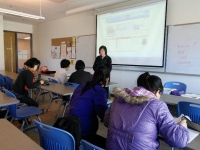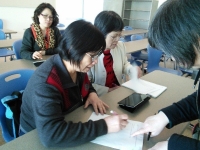Pathways to Learning and Citizenship
San Francisco Public Library, Calif.
Innovation Synopsis
San Francisco Public Library (SFPL) supports Chinese and Spanish language populations with limited English proficiency with learning opportunities that accelerate English language acquisition and preparation for citizenship by complementing traditional instruction with the use of mobile devices and resources such as mobile apps, online platforms, and social media interaction.
Challenge/Opportunity
San Francisco has diverse immigrant populations and supports pro-immigrant services. Economic mobility within these populations may be limited by linguistic isolation and citizenship. The Asian population served by Chinatown Branch consists of 81% Asian language households; the Latino population served by Excelsior Branch consists of 27% Spanish language households; and the Latino population served by Mission Branch consists of 42% Spanish language households. These branches serve communities with the need for English language acquisition to improve quality of life, economic mobility, and pathways to citizenship. Some challenges include convenience of instruction, lack of literacy, and limited knowledge of available resources. SFPL provides a connected learning model that addresses the need for English language acquisition, preparation for citizenship, and digital literacy instruction through a lending model that allows external check out and use of mobile devices such as laptops and tablets. This program also provides digital literacy instruction through gamification learning techniques and utilizing mobile apps, on-line platforms, and social media interactions that complement formal instruction to enhance the learning experience. This program accelerates English language acquisition and paths to citizenship; builds a networked community of learners and support; increases access, knowledge, and use of library resources; and provides digital literacy instruction through participatory learning that includes variety of teaching methodologies and strategies in delivering instruction to adults with a wide-range of learning levels.
Key Elements of Innovation
Phase One: In partnership with Learning Games Network (LGN), a non-profit organization that develops electronic game based educational tools, and the Bill and Melinda Gates Foundation that provided funding for external checkout laptops and additional temporary Bilingual/Spanish speaking staff to support training, the “En Ruta al Inglés“ (The Road to English) was implemented at Excelsior and Mission Branches. 62 participants completed 15 weeks of instruction with the goal to accelerate English language acquisition with Spanish language populations. LGN provided and developed a curriculum, instruction manual, and online platform for engaging adult learners in a virtual environment that provided gamified learning; tracked and measured participation and learning levels; and utilized social media interaction to deliver participatory learning. SFPL staff conducted outreach and marketing to solicit participation; facilitated digital literacy instruction; engaged adults in a variety of educational experiences that encouraged self-directed learning; and evaluated and modified the project in order to scale and sustain the program. Phase Two included partnerships and collaboration with City College of San Francisco (CCSF) Chinatown Campus and Mission Campus. A Friends of SFPL Innovation Grant funded mobile tablets for external check out. Over the course of a semester, Chinatown Branch worked with a class of 30 Chinese language students enrolled in an ESL class focused on citizenship/naturalization. The Mission Campus worked with a class of 40 Spanish language ESL students focused on English language Acquisition; although most students’ primary language was Spanish, each semester included speakers of Arabic, Cantonese, Farsi and Mandarin. The Branch staff collaborated with CCSF instructors to incorporate the use of tablets and technology into their existing curriculum and traditional, formal teaching structure.
Achieved Outcomes
This program was able to improve the quality of life, learning experiences and economic mobility for approximately 140 participants with limited English language proficiency by bridging the technology gap and supporting lifelong learning through partnership and community engagement.
Outcomes include:
- Increasing access and use of digital content and mobile devices
- Bringing awareness and increasing usage of free library resources such as Mango Languages, PowerSpeak, Learning Express Library and BrainFuse by demonstrating the students’ ability to use databases for language acquisition and citizenship preparation
- Enabling students with limited technology experience to demonstrate their ability to use the mobile devices to access information; connect to free Wi-Fi; take pictures and record mock interviews; and transition skills from library devices to using their personal smart phones
- Creating new populations of library users by connecting learning opportunities to home, work, social interaction, and community
- Developing a scalable and sustainable service model for lending mobile devices to targeted audiences in order to enhance learning, improve access to information, and accelerate English acquisition
- Developing a new partnership and outreach opportunity with San Francisco General Hospital and Barnett Briggs Medical Library to provide health literacy to Spanish language patients
- Strengthening partnership and collaboration with educational institutions
As part of the program evaluation and assessment, pre and post surveys were conducted to show the increase in use of library resources; determine satisfaction with the program; and determine the impact of integrating technology and mobile device into a traditional learning environment.


